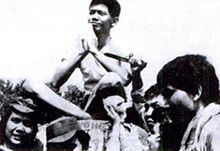Soe Hok Gie facts for kids
Quick facts for kids
Soe Hok Gie
|
|
|---|---|
| 史福義 | |

Soe at a rally on Mount Pangrango (1967)
|
|
| Born | 17 December 1942 Djakarta, Japanese-occupied East Indies
|
| Died | 16 December 1969 (aged 26) |
| Resting place | Jakarta, Indonesia |
| Nationality | Indonesian |
| Alma mater | University of Indonesia |
|
Notable work
|
Catatan Seorang Demonstran |
| Parent(s) | Salam Sutrawan (Soe Lie-Piet) (father) & Nio Hoey-An (mother) |
| Relatives | Arief Budiman (Soe Hok-Djin) (brother) |
| Soe Hok Gie | |||||||||||||
|---|---|---|---|---|---|---|---|---|---|---|---|---|---|
| Traditional Chinese | 史福義 | ||||||||||||
| Simplified Chinese | 史福义 | ||||||||||||
|
|||||||||||||
Soe Hok Gie (born December 17, 1942 – died December 16, 1969) was an Indonesian activist. He was known for speaking out against the governments of Presidents Sukarno and Suharto.
Contents
Who Was Soe Hok Gie?
Soe Hok Gie was an Indonesian person of Chinese background. He was also a Roman Catholic. He was the fourth of five children in his family. His father, Soe Lie Piet, was a writer and magazine editor. His older brother, Arief Budiman, became a sociologist (someone who studies society) and a university teacher. His brother also spoke out about important issues in Indonesian politics.
Soe's Education and Activism
Soe went to Kanisius for high school. Then, from 1962 to 1969, he studied at the University of Indonesia (UI). After finishing university, he became a teacher there.
During his time as a student, Soe became an active voice for change. He protested against President Sukarno and the PKI. Soe was a very active writer. His articles appeared in many newspapers like Kompas, Harian Kami, Sinar Harapan, Mahasiswa Indonesia, and Indonesia Raya.
After a movie about him called Gie was released in 2005, his articles were collected. They were published again in a book titled Zaman Peralihan, which means Transition Era.
Soe's Love for Nature
Soe loved being close to nature. He once wrote in his diary a quote from the poet Walt Whitman: "Now I see the secret of the making of the best person. It is to grow in the open air and to eat and sleep with the earth."
In 1965, Soe helped start Mapala UI. This was a student group focused on protecting the environment. He really enjoyed hiking. Sadly, he died while hiking up the volcano Mount Semeru. He breathed in poisonous gas the day before his 27th birthday.
Soe was buried in a place that is now the Museum of the Park of Memorial Stones in Central Jakarta.
Soe's Thoughts on Life
Soe once wrote something interesting in his diary:
- "Seorang filsuf Yunani pernah menulis ... nasib terbaik adalah tidak dilahirkan, yang kedua dilahirkan tapi mati muda, dan yang tersial adalah umur tua. Rasa-rasanya memang begitu. Bahagialah mereka yang mati muda."
This means, "A Greek philosopher once wrote... the best fate is to never be born. The second best is to be born but die young. And the worst is to live to old age. It feels true: Happy are those who die young." Soe believed this idea came from an unknown Greek philosopher.
Books and Films About Soe
Soe's personal diary was published in 1983. It was called Catatan Seorang Demonstran, which means Annotations of a Demonstrator. His university paper was also published as Di Bawah Lantera Merah (Under the Red Lantern).
The Movie Gie
Soe's diary was the main inspiration for a 2005 film titled Gie. The movie was directed by Riri Riza. The actor Nicholas Saputra played Soe Hok Gie in the film.
Other Books About Soe
Soe is also the main topic of a book written in 1997 by Dr. John Maxwell. This book was called Soe Hok-Gie: Diary of a Young Indonesian Intellectual. It was later translated into Indonesian in 2001. The Indonesian title was Soe Hok-Gie: Pergulatan Intelektual Muda Melawan Tirani. This means Soe Hok-Gie: A Young Intellectual's Struggle Against Tyranny.
See also
- Gie, a 2005 film based on his life
- List of Chinese Indonesians

